Cedar Trees in Texas (With Pictures) – Identification Guide
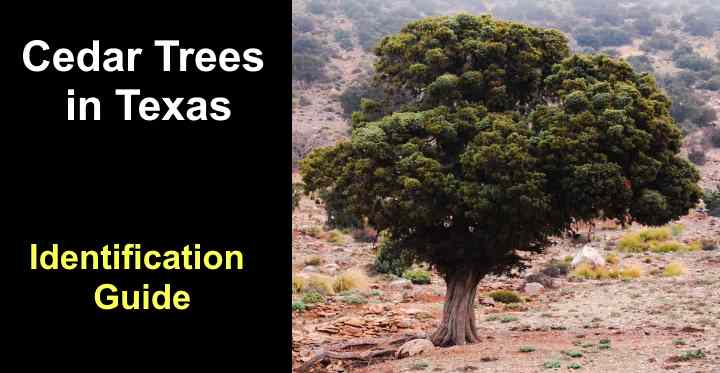
Cedar trees are a common sight in Texas. However, these are not true cedar trees from the genus Cedrus; instead, they belong to the juniper species (genus Juniperus). Trees from the genus Juniperus have distinct features and unique characteristics.
Cedars in Texas are typically medium to large-sized trees with reddish brown bark, scale-like leaves, and small berry-like cones. Also, cedars in Texas are known for their ability to thrive in dry, rocky soil conditions. They also have a distinctive cedar-like fragrance when crushing the aromatic leaves.
Cedar trees in Texas have a crucial role in the State’s ecosystem. They provide habitat and food for various wildlife species, like the golden-cheeked warbler. However, their rapid spread and potential negative environmental impact have caused concerns among conservationists and landowners. Additionally, they release pollen, which can cause allergic reactions—often called cedar fever.
This article is a comprehensive identification guide for Cedar trees in Texas. You will find descriptions and pictures of Cedar trees native to the Lone Star State.
Common Types of Cedar Trees in Texas
Texas is home to eight species of cedar trees, the most common being the mountain red cedar (Juniperus scopulorum) and rock cedar (Juniperus ashei). Other native cedar tree species include the eastern red cedar, weeping cedar, alligator cedar, and oneseed cedar that are common coniferous trees in the Lone Star State.
Characteristics of Texas Cedars
Texas cedars are evergreen coniferous trees in the cypress family Cupressaceae and genus Juniperus. The evergreen trees typically have a narrow, pyramidal to columnar habit with aromatic blue-green to dark green scale-like leaves. They also produce small cones resembling berries. Typically, cedar trees in Texas grow between 15 and 50 ft. (4.5 – 15 m) tall.
Cedars are well-suited to growing in southern states. Texas has various soil types where cedars and junipers thrive. Additionally, cedars tend to be drought-tolerant conifers that thrive in long periods of drought. They are also resilient trees with fire-resistant properties, making them vital plants for Texas ecosystems.
It’s important to note that Texas cedars are actually junipers. Therefore, they should not be confused with true cedars—coniferous trees in the genus Cedrus. Texas cedars are typically smaller, with a more columnar form than true cedar trees. Also, Texas cedars produce soft, berry-like cones, not woody cones typical of most conifers.
Mountain Red Cedar (Juniperus scopulorum)
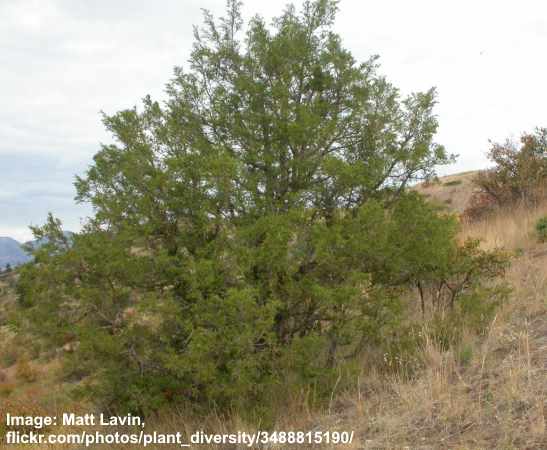
The mountain red cedar is a slow-growing southern conifer with a pyramidal habit or rounded form. The stunning evergreen tree is known for its reddish-brown bark, aromatic, blue-green scale-like leaves, and waxy dark blue juniper berries. The cedar’s bark peels into strips, adding to its ornamental appeal. The cedar doesn’t grow taller than 40 ft. (12 m).
Native to Texas, the mountain red cedar thrives in full sun and moist, well-drained soils. It also performs well in southern coastal areas, tolerating drought, salt spray, and dry soil. The aromatic conifer attracts wildlife like the evening grosbeak and northern mockingbird.
Mountain red cedar bark is red or burgundy and develops deep furrows as it matures. The reddish bark exfoliates in thin strips.
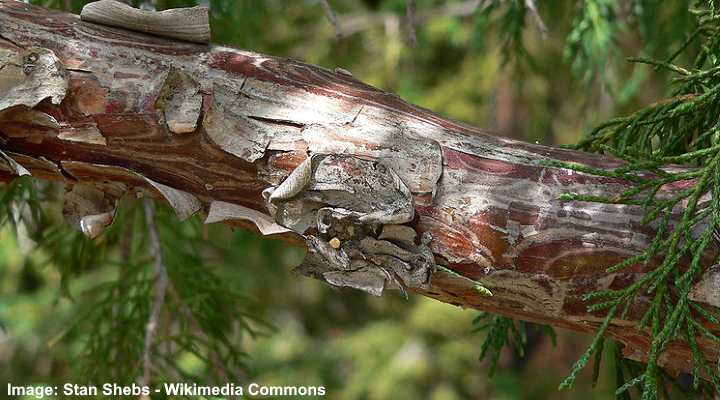
Mountain red cedar bark
Mountain red cedar leaves are aromatic with a green-silvery appearance. The scale-like leaves are soft and measure up to 0.12” (3 mm) long.
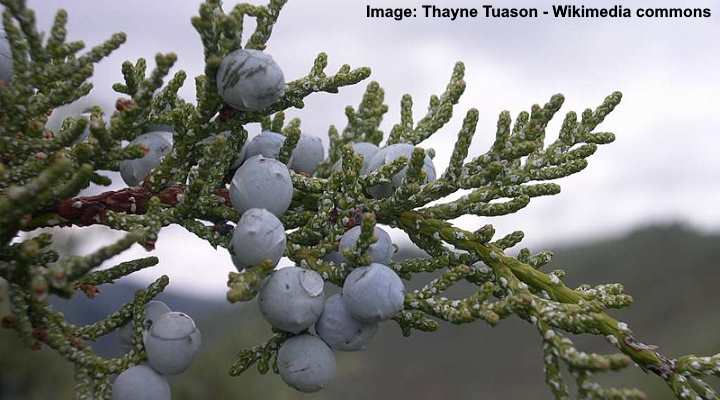
Mountain red cedar leaves and cones
Mountain red cedar cones are small, round, dark blue berry-like fruits. They have a blue-white waxy cover, and each fleshy cone contains two seeds.
The mountain red cedar is useful as a shade tree in hot southwestern climates. Due to its tolerance to pollution, it is good for urban environments. Due to its dense foliage, this cedar performs well as a windbreak or privacy screen.
- USDA Growing Zone: 3 to 7
- Size: 30 to 40 ft. (9 – 12 m) tall and 3 to 15 ft. (0.9 – 4.5 m) wide
- Light: Full sun or partial shade
- Soil: Well-drained, dry to medium rocky soils
- Areas of Texas: Texas panhandle and west Texas
Rock Cedar (Juniperus ashei)
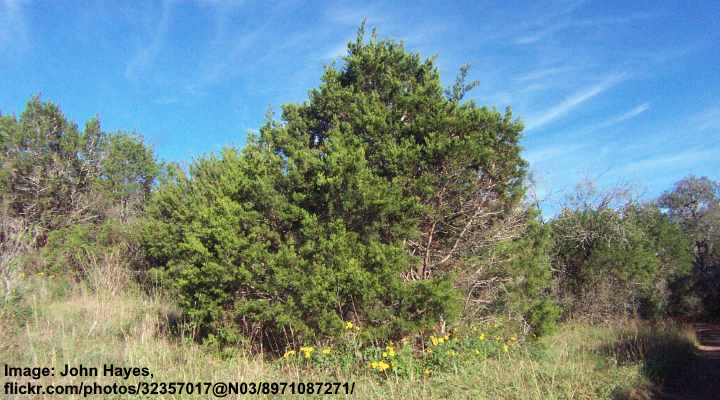
Native to Texas Hill Country, the rock cedar is a small to medium-sized evergreen juniper tree. The cedar is characterized by its gray to reddish bark, scale-like green leaves, and flattened to rounded crown. Sometimes growing as a shrub, the rock cedar has branches low to the ground.
Also called the Ashe juniper, this Texas cedar is a hardy and adaptable conifer. Its resilience lets it thrive in harsh climatic conditions, making it popular for landscaping in Texas. The native cedar tolerates heat, drought, and poor soil conditions and thrives in rocky or sandy soils.
Rock cedar bark is rough and scaly in texture, often with a reddish-brown to grayish-brown color. The bark of rock cedar trees is thicker than most other cedars, making it more fire-resistant.
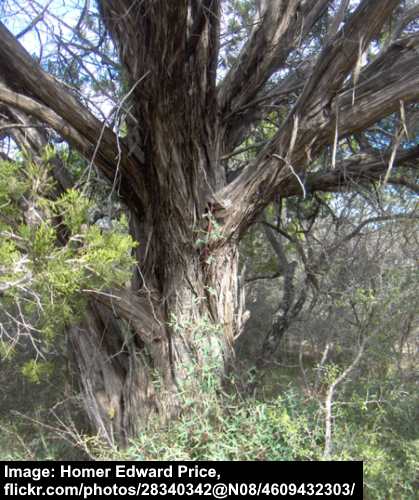
Rock cedar bark
Rock cedar leaves are scale-like and dark green on the top side with paler undersides. The fragrant cedar leaves have a strong scent and are minutely saw-toothed.
Rock cedar cones are blue berry-like fruit cones with a pale, waxy appearance with one seed per cone. Typically, male cones produce pollen, while female cones have a white, waxy coating.
The rock cedar doesn’t grow taller than 25 ft. (7.6 m) tall and wide. Landscaping uses in Texan landscapes include planting as a privacy screen, xeriscaping, and accent trees. Besides its ornamental value, the Texas cedar provides wildlife habitat and food, especially the rare golden-cheeked warbler.
- USDA Growing Zone: 6 to 9
- Size: 15 to 25 ft. (4.5 – 7.6 m) tall and wide
- Light: Full sun
- Soil: Well-drained, limestone-based rocky soils, however, also adapts to loamy and clay soils
- Areas of Texas: Central, Western, and Southern parts of Texas
Oval Gland Juniper (Juniperus ashei var. ovata)
The oval gland juniper—also called the Ozark white cedar—is a small native conifer related to the rock cedar. This Texas cedar has a dense, irregular, rounded crown, exfoliating grayish bark, and dark blue berries. Its dark green scale-like leaves are grayish-green in color and emit a pleasant aroma when crushed.
The oval gland juniper is well-suited for Texas’s hot and arid climates. It thrives in full sun and can tolerate a wide range of soil conditions, including rocky and sandy soils. The cedar is also highly drought-tolerant, making it an excellent choice for xeriscaping or water-wise landscaping.
- USDA Growing Zone: 7 to 9
- Size: Up to 30 ft. (9 m) tall and 10 ft. (3 m) wide
- Light: Full sun
- Soil: Well-drained, sandy or rocky soils
- Areas of Texas: Central and Western Texas
Eastern Red Cedar (Juniperus virginiana)

The eastern red cedar is an evergreen conifer with a conical or pyramidal crown with a columnar habit. This medium-sized cedar has dense foliage, reddish-brown bark that peels off in long, thin strips, and fragrant, fine-cut leaves. Like all Texas cedars, the female tree has dark purple-blue berry-like cones, and the male tree has brown cones.
Also called the pencil cedar or Virginia juniper, this native cedar grows up to 50 ft. (15 m) tall. It adapts well to Texas landscapes due to its heat, cold, and drought tolerance. It performs well in various soil types, including dry and rocky soils. The slow-growing evergreen conifer tolerates salt spray, making it suitable for coastal landscapes.
Eastern red cedar bark is fibrous and gray to reddish-brown that exfoliates on mature trees.
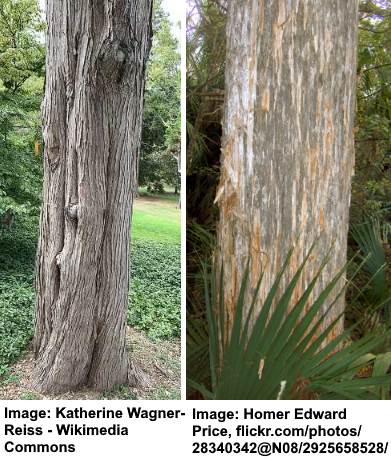
Eastern red cedar bark
Eastern red cedar leaves are dark green or bluish-green and have a sharp, pointed tip on younger trees up to three years old. Mature trees have scale-like leaves 0.16” (4 mm) long, growing in whorls of three.

Eastern red cedar leaves
Eastern red cedar cones are round, berry-like fruits with a blue color. The seed cones are 0.28” (7 mm), containing up to three seeds. The juicy fruits are an important food source for many birds.

Eastern red cedar cones
The eastern red cedar has many landscaping uses due to its rapid growth and dense foliage. Its columnar growth makes it ideal for planting as a large screen or evergreen privacy hedge. It also makes an effective windbreak or focal point in open Texas landscapes.
- USDA Growing Zone: 2 to 10
- Size: 40 to 50 ft. (12 – 15 m) tall and 8 to 20 ft. (2.4 – 6 m) wide
- Light: Full sun to partial shade
- Soil: Well-drained, dry to medium soils and is drought-tolerant once established
- Areas of Texas: Eastern Texas, Texas Hill Country, and the Texas Panhandle
Drooping Cedar (Juniperus flaccida)
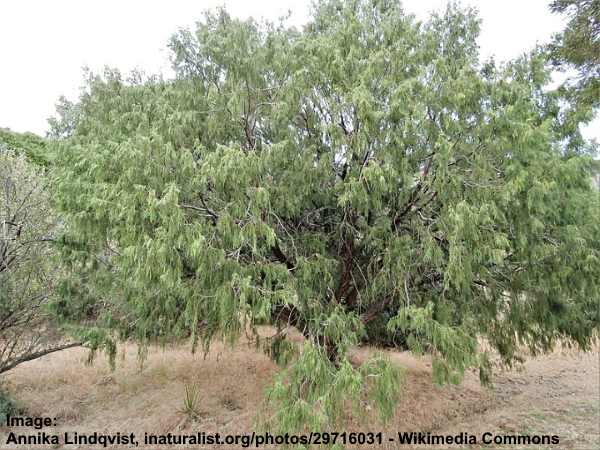
The drooping cedar is a small evergreen tree with weeping foliage of soft, dark green sprays. Native to Western Texas, the unique cedar has branches that hang down, giving it a graceful appearance. It has berry-like seed cones, needle-like leaves 0.4” (10 mm) long, and brown, stringy bark.
Also called the weeping juniper, the Texas cedar doesn’t grow taller than 33 ft. (10 m) tall. The heat-hardy cedar tolerates a wide range of soil types, including rocky or sandy soils. It’s also drought-tolerant once established, making it a great ornamental tree for xeriscaping or water-wise gardens.
Drooping cedar bark is cinnamon-brown or gray with vertical fissures. Like most Texas cedars, it exfoliates in scaly plates.
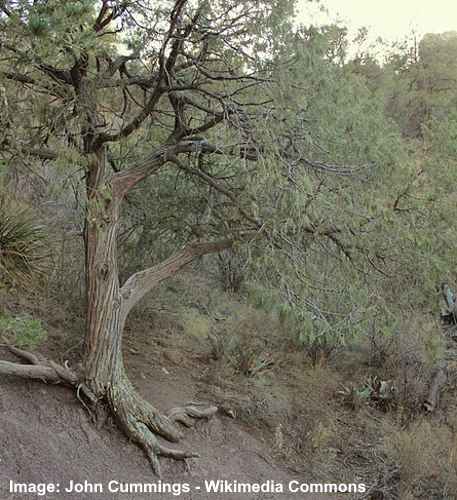
Drooping cedar bark
Drooping cedar leaves wilt, creating a weeping effect as they dangle from branches. The scale-like leaves grow up to 0.16” (4 mm) long.
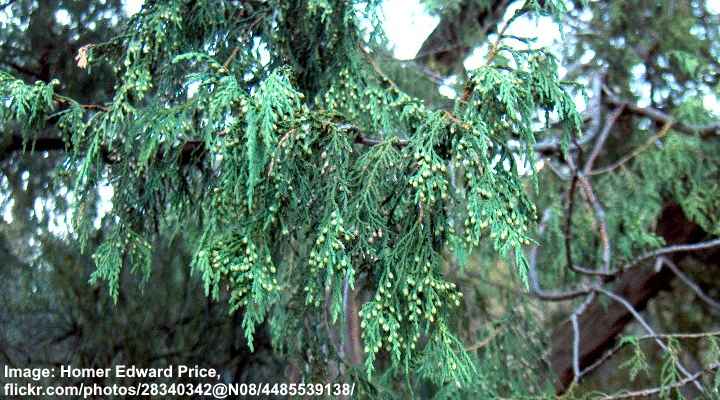
Drooping cedar leaves
Drooping cedar cones are large, brownish-purple berry-like cones that contain up to 12 seeds—the most of any juniper tree. The large seed cones can measure up to 0.78” (20 mm) in diameter.
The drooping cedar can be an elegant addition to landscaping in yards in the Lone Star State. Its weeping habit makes it an ideal specimen or lawn tree choice.
- USDA Growing Zone: 8 and 9
- Size: 15 to 30 ft. (4.5 – 9 m) tall and 10 to 15 ft. (3 – 4.5 m) wide
- Light: Full sun to partial shade
- Soil: Well-drained, adaptable to various soil types
- Areas of Texas: Southwest Texas
Alligator Cedar (Juniperus deppeana)

The alligator cedar is one of the largest cedars in Texas. It gets its name from its distinctive gray bark resembling an alligator’s rough skin. Identifying features of this Texas cedar include its pyramidal shape with a rounded crown, dark, blue-green scale-like leaves, and copper-colored seed cones. Its bark fissures into rectangular blocks as it matures.
The alligator cedar is well-suited to hot, dry climates and tolerates various soil conditions. A distinguishing feature of the cedar is its tall stature but relatively short trunk. This means that branches grow relatively low to the ground. Also called the checkerback juniper, the tree grows up to 50 ft. (15 m) tall.
Alligator cedar bark is one of the most recognizable Texas cedar trees. Mature cedars have bark with thick plates in square gray scales resembling a checkerboard or an alligator’s skin. It’s one of the most distinctive Texas cedars in the south.
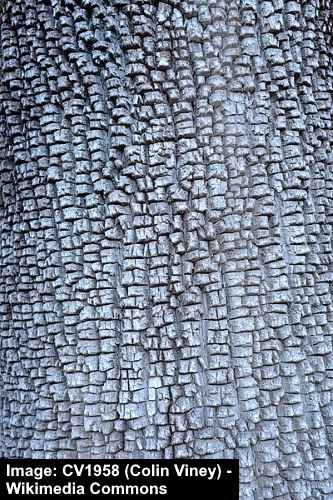
Alligator cedar bark
Alligator cedar leaves are dark blue-green and scale-like, growing up to 0.2” (5 mm) long. They have a distinct cedar aroma when crushed.
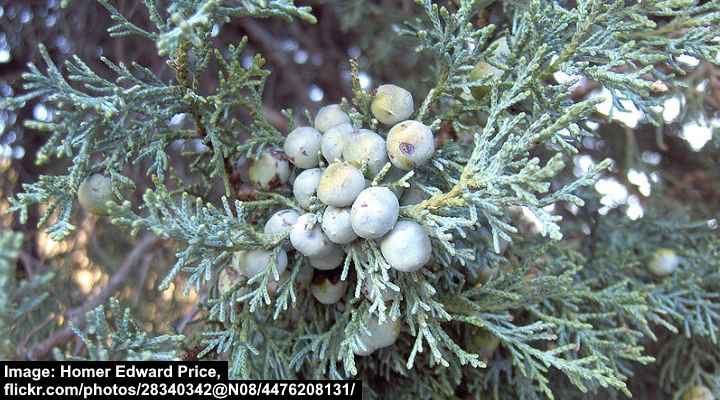
Alligator cedar leaves and cones
Alligator cedar cones are fleshy, berry-like reddish-brown cones with white waxy coating measuring up to 0.5” (13 mm) long.
The alligator cedar has a striking appearance in southern landscapes. You can plant the evergreen coniferous tree as a tall windbreak or privacy screen. Its dense, spreading canopy also provides shade in the scorching sunshine.
- USDA Growing Zone: 7 to 9
- Size: Up to 40 ft. (12 m) tall and 10 to 20 ft. (3 to 6 m) wide
- Light: Full sun
- Soil: Well-drained, dry to medium rocky soils
- Areas of Texas: Southwestern Texas
Oneseed Juniper (Juniperus monosperma)

Also called the West Texas Juniper, this medium-sized evergreen conifer is a multi-stemmed tree with blue-green scale-like leaves. Ideal for growing in the Lone Star State, the cedar thrives in rocky, dry, or sandy soil. It has fragrant needle-like leaves, dark gray bark, and small, round, bluish-gray berries with one seed.
An unusual feature of the oneseed juniper is its orange flowers. However, these insignificant blooms quickly give way to fleshy seed cones. Also, compared to other junipers, the tree grows relatively fast and is long-lived. This feature creates gnarled branches, adding to the cedar’s ornamental appeal.
Oneseed juniper bark has fibrous bark that is thin and scaly. The gray-brown outer bark peels in thin strips to reveal an orange-brown bark underneath.
Oneseed juniper leaves are needle-like green leaves in a yellowish-green to gray-green color.
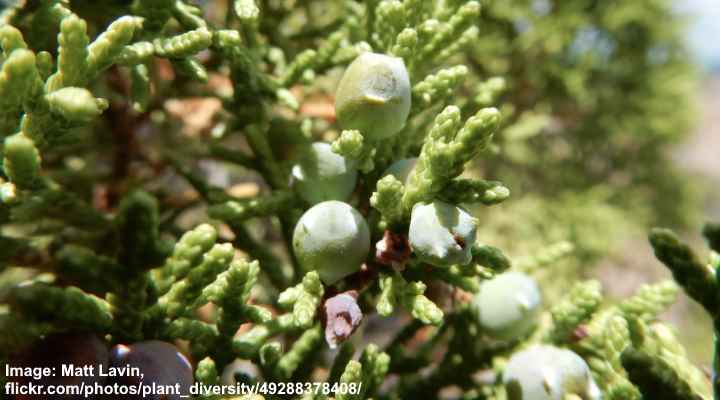
Oneseed juniper leaves and immature cones
Oneseed juniper cones are bluish or brownish-colored and only contain one or two seeds.
This juniper species is a popular ornamental tree for landscaping in arid regions. It can withstand harsh conditions like drought, heat, salt spray, and dry soil.
- USDA Growing Zone: 4 to 8
- Size: 10 to 20 ft. (3 – 6 m) tall and 6 to 12 ft. (1.8 – 3.6 m) wide
- Light: Full sun
- Soil: Well-drained, sandy or alkaline soils
- Areas of Texas: West Texas and the Texas Panhandle
Redberry Juniper (Juniperus coahuilensis)
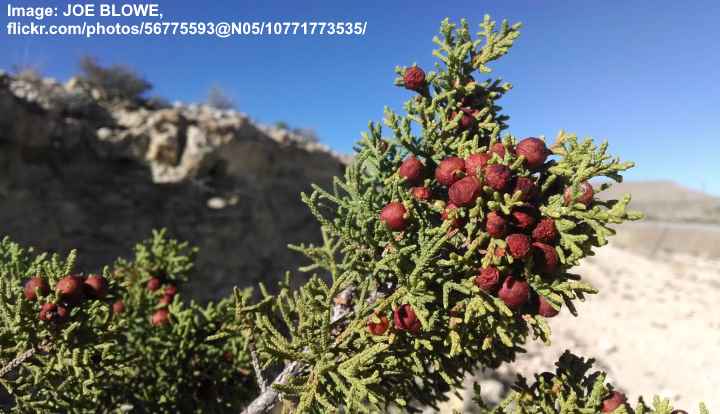
The redberry juniper is a shrub-like evergreen tree native to the arid regions of Texas and Mexico. Identifying features of the Texas cedar are its characteristic dense, compact growth habit, attractive red berries, light green leaves, and exfoliating brown to gray bark.
This juniper species thrives in full sun and well-drained soils, making it well-suited for arid and rocky landscapes. It is highly drought-tolerant and can withstand hot and dry conditions. The redberry juniper is also adapted to poor soil conditions and often grows in limestone or calcareous soils.
Redberry juniper bark is reddish-brown and matures to rough and scaly with a gray appearance. Like many other native Texas cedars, it exfoliates bark in long strips.
Redberry juniper leaves are small and needle-like, growing up to 0.5” (13 mm) long with a pointed tip. They come in shades of dark green to light green, and some may have a slight tinge of yellow or red.
Redberry juniper cones are distinctive because the small, rounded, fleshy cones are yellow-orange to dark red, giving the cedar its common name.
The redberry juniper is useful in landscaping as a low-maintenance shrub or small tree. You can plant the cedar in xeriscapes or as a windbreak, privacy hedge, or screen. Besides its ornamental value, the small redberry juniper tree provides important habitat and food for wildlife.
Birds, such as the cedar waxwing and northern bobwhite, feed on the berries in fall.
- USDA Growing Zone: 7 to 10
- Size: Typically grows 6 to 25 ft. (1.8 – 7.6 m) tall
- Light: Full sun
- Soil: Well-drained, rocky or sandy soils
- Areas of Texas: South and West Texas, including the Edwards Plateau and Trans-Pecos regions
Pinchot’s Juniper (Juniperus pinchotii)

Pinchot’s juniper is a small evergreen conifer with orange-red berry-like cones. The native multi-trunked Texas cedar tree has scale-like leaves, brightly colored reddish seed cones, and pale gray exfoliating bark. The small shrub-like cedar doesn’t usually grow taller than 20 ft. (6 m) tall. It has a compact, rounded form.
This Texas cedar tree is highly adapted to arid and desert environments. This fact makes it ideal for xeriscaping and water-wise landscapes. It is drought-tolerant and can survive in poor, rocky soils with low fertility. Pinchot’s juniper prefers full sun but can tolerate some shade.
Pinchot’s juniper cedar bark is thin, gray, and scale-like, peeling in narrow strips. This exposes orange-brown bark underneath.
Pinchot’s juniper cedar leaves are dark green and grow densely on the aromatic branches. Like all Texas cedars, they exude a whitish resin that produces white speckles on the leaves.
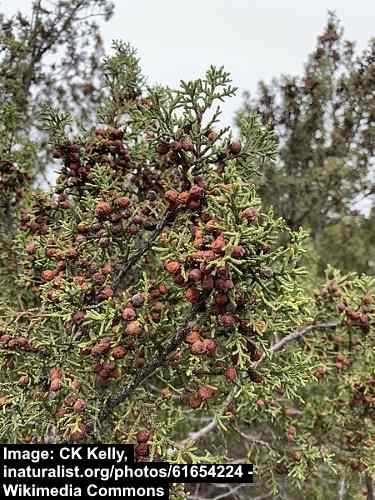
Pinchot’s juniper leaves and cones
Pinchot’s juniper cedar cones are reddish-brown fruits that typically have one seed per fleshy cone.
Pinchot’s juniper is a hardy, drought-tolerant cedar tree, making it ideal for landscaping in arid conditions. You can plant the small shrub-like cedar tree as an accent tree in xeriscaping, a shade tree for southern gardens, or a windbreak.
- USDA Growing Zone: 6 to 9
- Size: 10 to 20 ft. (3 – 6 m) tall and up to 25 ft. (7.6 m) wide
- Light: Full sun or partial shade
- Soil: Well-drained, dry, gravelly, or rocky soils
- Areas of Texas: Desert regions of west Texas
Related articles:
